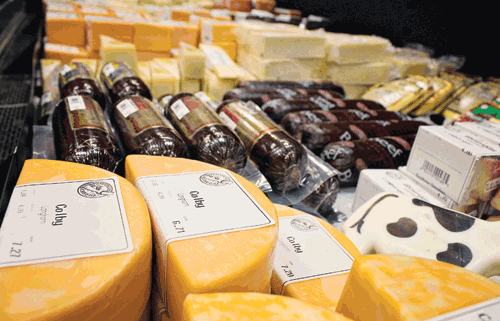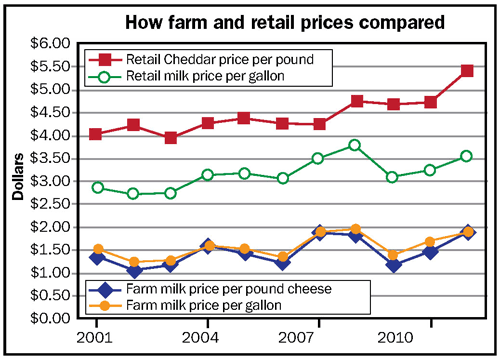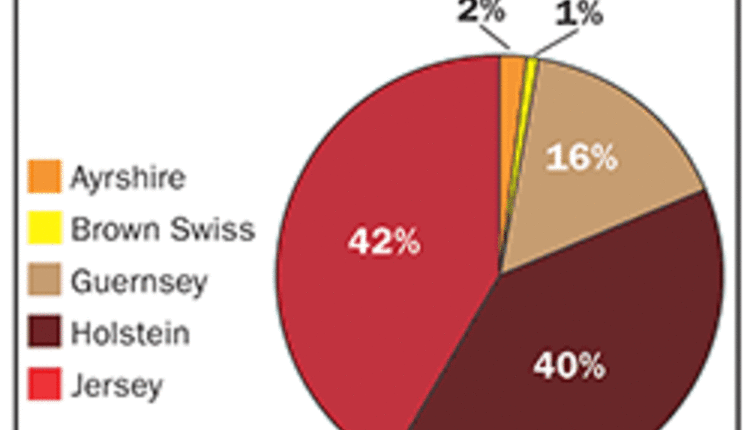The author is a consultant and retired Dairy Cooperative CEO.

Common questions I received from dairy farmers over the years include: How does the price I receive for my milk compare to the retail price of dairy products? When my milk check goes down, does the price for milk, cheese, butter and ice cream in the grocery store go down as well?
First, dairy processors and manufacturers pay for milk based on the products they produce. For example, a fluid processor pays the Class I price for milk, and a cheesemaker pays the Class III price. The price most of you receive for your milk is not the same price an individual processor or manufacturer pays for the raw milk. Federal and state marketing orders, as well as cooperatives, "blend" milk payments from the various milk buyers to pay dairy farmers a "blend price."
Second, not all processors and manufacturers use raw milk exactly as it comes from the farm. Average farm milk contains about 3.6 percent butterfat. Yet, fluid milk, when sold at retail, is standardized to 3.25 percent butterfat or less. Depending upon the type of cheese made, a cheesemaker may remove butterfat or add to milk's protein content. In making butter, farm milk is separated into skim and butterfat, with the butterfat used to make butter. To make a fair comparison between retail and farm milk prices, the price a processor or manufacturer pays for milk used in the dairy products they are producing, not the farm milk price, must be used.
Third, I have used national average prices. Your individual market will be different.
The figure shows the relationship between the farm milk prices and the retail prices of fluid milk and cheese. It compares the average U.S. whole milk (3.25 percent fat) retail price per gallon as published by the Bureau of Labor Statistics (BLS) to the farm milk cost for a gallon of whole milk. (Each month, BLS publishes an average retail price for four dairy products: whole milk, Cheddar cheese, butter and ice cream.) The announced average cooperative Class I (fluid) price, as reported in Dairy Market News, is used to calculate the farm milk price.
Farm and retail milk prices follow a similar pattern. When the farm price declines, the retail milk price declines, and vice versa. Both retail and farm prices showed much variation from 2001 to 2011. The retail price varied $1.04 per gallon from low to high, while the farm price varied 73 cents per gallon from low to high. As a percentage of the retail price, the farm price averaged 50 percent from 2001 to 2011.
However, during times of high farm prices, the farm price percentage of the retail price is higher compared to times of low farm milk prices. For example, the percentage was 56 percent in 2011 (record-high milk price) and 46 percent in 2009 (low milk price). It appears that, when farm prices are moving up, all of the rise is not included in the retail price. When farm milk prices decline, not all of the drop is reflected in the retail price.

The average U.S. Cheddar cheese retail price per pound as reported by BLS is compared to the farm milk price also in the figure. The farm price is the federal order Class III price average converted to a milk price per pound of cheese.
The farm milk price as a percentage of the retail Cheddar price averaged 33 percent from 2001 to 2011. Changes in farm prices do not necessarily mean a corresponding change in the retail cheese price. From 2006 to 2007, the farm milk price on a per-pound cheese basis rose 52 percent, but the retail Cheddar cheese price only went up 1 percent. From 2009 to 2011, the farm milk price shot up 62 percent, while the retail Cheddar price went up 16 percent.
No doubt one of the causes for these differences is by-products. Besides cheese, cheesemakers have whey and fat to sell. During the previous years mentioned, both the price of whey and butterfat rose significantly. This by-product income could offset the cost of the raw milk used to make cheese.
Another factor in cheese pricing is that the time between receiving the milk from the farm and when the finished product hits the retail shelf needs to be considered. With fluid milk, milk received and processed at a plant today could well be on the grocery shelf tomorrow. When it comes to cheese, the milk may be made into cheese the day it is received at the plant, but it may several months before the finished product is retailed. The price of farm milk at the time the cheese is sold to the consumer will most likely be different than when the cheese was made.
Butter trends are similar
Butter contains about 82 percent butterfat. I looked at the average federal order Class IV butterfat price for the years 2001 to 2011 to price the raw butterfat.
The correlation between the retail butter price and the farm butterfat price is strong. During the 10-year period, the cost of butterfat contained in butter was about 41 percent of the retail butter price. As with fluid milk, it appears that, during a time of rising prices, not all of the rise in butterfat is included in the retail price, and the opposite occurs when the butterfat price declines. As in cheesemaking, making butter produces a marketable by-product, buttermilk.
Looking at the big picture, the percentage of dairy ingredient cost for each of these three dairy products is about the same in 2011 as it was back in 2001. The same was true for ice cream.
Granted, there were ups and downs during the 10 years. Those ups and downs can be explained due to retailers reducing retail price volatility by not reflecting all of farm milk price rises or falls. And, for cheese, the price of by-products, such as whey, accounts for some of the variation.
The cost to produce 100 pounds of milk has jumped, significantly, during the past 10 years. Likewise, dairy processors and manufacturers have incurred major cost rises as well. All transportation costs are much higher today compared to 2001.
Over the past 10 years, farm price percentage of retail for fluid, Cheddar, butter and ice cream have been 50, 33, 41 and 19 percent, respectively. For the cost of raw dairy products as a percentage of the retail price to be about the same in 2011 versus 2001 speaks well of all involved in the dairy industry from the dairy farmer to the processor or manufacturer to the retailer.

Common questions I received from dairy farmers over the years include: How does the price I receive for my milk compare to the retail price of dairy products? When my milk check goes down, does the price for milk, cheese, butter and ice cream in the grocery store go down as well?
First, dairy processors and manufacturers pay for milk based on the products they produce. For example, a fluid processor pays the Class I price for milk, and a cheesemaker pays the Class III price. The price most of you receive for your milk is not the same price an individual processor or manufacturer pays for the raw milk. Federal and state marketing orders, as well as cooperatives, "blend" milk payments from the various milk buyers to pay dairy farmers a "blend price."
Second, not all processors and manufacturers use raw milk exactly as it comes from the farm. Average farm milk contains about 3.6 percent butterfat. Yet, fluid milk, when sold at retail, is standardized to 3.25 percent butterfat or less. Depending upon the type of cheese made, a cheesemaker may remove butterfat or add to milk's protein content. In making butter, farm milk is separated into skim and butterfat, with the butterfat used to make butter. To make a fair comparison between retail and farm milk prices, the price a processor or manufacturer pays for milk used in the dairy products they are producing, not the farm milk price, must be used.
Third, I have used national average prices. Your individual market will be different.
The figure shows the relationship between the farm milk prices and the retail prices of fluid milk and cheese. It compares the average U.S. whole milk (3.25 percent fat) retail price per gallon as published by the Bureau of Labor Statistics (BLS) to the farm milk cost for a gallon of whole milk. (Each month, BLS publishes an average retail price for four dairy products: whole milk, Cheddar cheese, butter and ice cream.) The announced average cooperative Class I (fluid) price, as reported in Dairy Market News, is used to calculate the farm milk price.
Farm and retail milk prices follow a similar pattern. When the farm price declines, the retail milk price declines, and vice versa. Both retail and farm prices showed much variation from 2001 to 2011. The retail price varied $1.04 per gallon from low to high, while the farm price varied 73 cents per gallon from low to high. As a percentage of the retail price, the farm price averaged 50 percent from 2001 to 2011.
However, during times of high farm prices, the farm price percentage of the retail price is higher compared to times of low farm milk prices. For example, the percentage was 56 percent in 2011 (record-high milk price) and 46 percent in 2009 (low milk price). It appears that, when farm prices are moving up, all of the rise is not included in the retail price. When farm milk prices decline, not all of the drop is reflected in the retail price.

The average U.S. Cheddar cheese retail price per pound as reported by BLS is compared to the farm milk price also in the figure. The farm price is the federal order Class III price average converted to a milk price per pound of cheese.
The farm milk price as a percentage of the retail Cheddar price averaged 33 percent from 2001 to 2011. Changes in farm prices do not necessarily mean a corresponding change in the retail cheese price. From 2006 to 2007, the farm milk price on a per-pound cheese basis rose 52 percent, but the retail Cheddar cheese price only went up 1 percent. From 2009 to 2011, the farm milk price shot up 62 percent, while the retail Cheddar price went up 16 percent.
No doubt one of the causes for these differences is by-products. Besides cheese, cheesemakers have whey and fat to sell. During the previous years mentioned, both the price of whey and butterfat rose significantly. This by-product income could offset the cost of the raw milk used to make cheese.
Another factor in cheese pricing is that the time between receiving the milk from the farm and when the finished product hits the retail shelf needs to be considered. With fluid milk, milk received and processed at a plant today could well be on the grocery shelf tomorrow. When it comes to cheese, the milk may be made into cheese the day it is received at the plant, but it may several months before the finished product is retailed. The price of farm milk at the time the cheese is sold to the consumer will most likely be different than when the cheese was made.
Butter trends are similar
Butter contains about 82 percent butterfat. I looked at the average federal order Class IV butterfat price for the years 2001 to 2011 to price the raw butterfat.
The correlation between the retail butter price and the farm butterfat price is strong. During the 10-year period, the cost of butterfat contained in butter was about 41 percent of the retail butter price. As with fluid milk, it appears that, during a time of rising prices, not all of the rise in butterfat is included in the retail price, and the opposite occurs when the butterfat price declines. As in cheesemaking, making butter produces a marketable by-product, buttermilk.
Looking at the big picture, the percentage of dairy ingredient cost for each of these three dairy products is about the same in 2011 as it was back in 2001. The same was true for ice cream.
Granted, there were ups and downs during the 10 years. Those ups and downs can be explained due to retailers reducing retail price volatility by not reflecting all of farm milk price rises or falls. And, for cheese, the price of by-products, such as whey, accounts for some of the variation.
The cost to produce 100 pounds of milk has jumped, significantly, during the past 10 years. Likewise, dairy processors and manufacturers have incurred major cost rises as well. All transportation costs are much higher today compared to 2001.
Over the past 10 years, farm price percentage of retail for fluid, Cheddar, butter and ice cream have been 50, 33, 41 and 19 percent, respectively. For the cost of raw dairy products as a percentage of the retail price to be about the same in 2011 versus 2001 speaks well of all involved in the dairy industry from the dairy farmer to the processor or manufacturer to the retailer.
This article appears on page 535 of the August 25, 2012 issue of Hoard's Dairyman.









